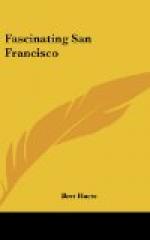Lincoln Park, with a municipal golf course on a headland overlooking the Golden Gate, affords a distant but luring view of San Francisco. In Lincoln Park is a replica of the Palace of the Legion of Honor in Paris, gift of Mr. and Mrs. A. B. Spreckels as a memorial to San Francisco’s soldiers in the world war. In addition to its art treasures it was built to house trophies from all the fronts on which the American expeditionary forces fought, Marshal Foch and other commanders having interested themselves in the collection.
The Palace of Fine Arts on the Marina close to the Presidio, with its masterpieces from the Phoebe A. Hearst and other collections, is a short drive from Lincoln Park. The city’s Aquatic Park is close by.
Sutro Heights, with its gardens, classic marbles and outlook upon the sea, is near the Cliff House above the Ocean Beach. The Seal Rocks and the Sutro baths are in sight of these heights.
San Francisco has established a new playground for children at the end of Sloat Boulevard, with a second municipal golf course and the largest outdoor swimming pool in the world among its attractions.
Music and Drama
Hasty reading of annals makes some people gather the mistaken impression that San Francisco’s dramatic and musical history had its genesis when miners threw gold nuggets at the feet of Lotta Crabtree. But it has been pointed out by one musical critic that the Franciscan padres were chanting Gregorian measures in the Mission Dolores when the battles of Lexington and Concord were being fought, and that the Indians were intoning hymns and staging miracle-plays for their sun-god in California before the landing of the Pilgrims at Plymouth Rock.
San Francisco not only discovered the gold in the soprano of Luisa Tetrazzini at the old Tivoli Opera House, but it has figured in the triumphs of many luminaries of the musical and dramatic stage—from Adelina Patti and Tamagno to Mary Garden and Galli-Curci—from Edwin Booth and Charles Kean to John Drew and Henry Miller. Celebrities braved the discomforts of trips across the continent from the earliest days because of the city’s repute as a place where the people were not only responsive but arrived at their own independent judgments.
Ysaye, Kreisler and Mischa Elman have esteemed the acclaim of audiences here as much as Ole Bull and Wieniawski did in earlier days.
Since the conversion of the Tivoli into a motion picture theatre, and pending the construction of the Memorial Opera House opposite the City Hall, the city hears most of its opera in the Civic Auditorium. Performances of the San Francisco Opera Company, with its local orchestra and chorus supporting international stars, and of visiting troupes from New York and Chicago in this auditorium provide two spectacles one on the stage and the other in the assemblage itself. The auditorium seats 10,000 persons. To be present when a prima donna awes this audience into silence by her tones, and then to hear a triumphant roar of approval rend the silence, is an unforgettable adventure of the spirit.




